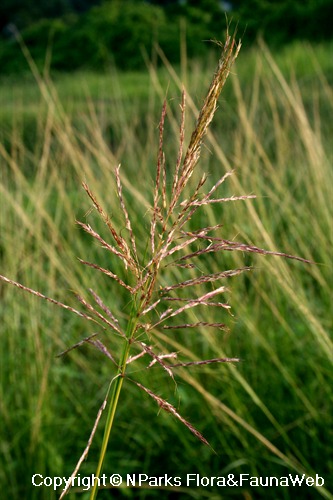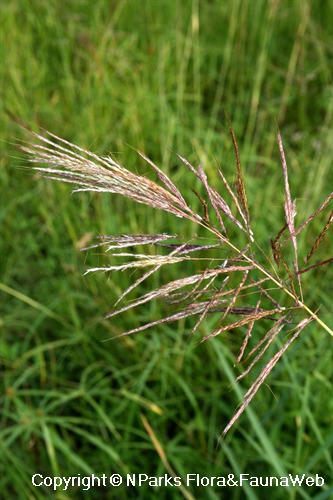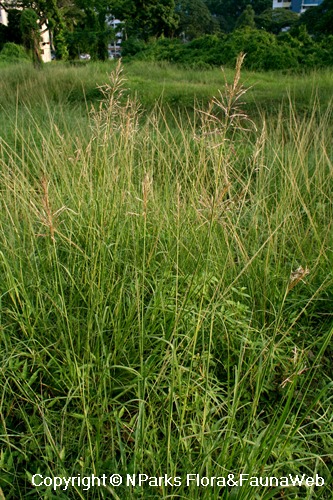
Back
Bothriochloa bladhii (Retz.) S.T.Blake
| Family Name: | Poaceae (Gramineae) |
| Synonyms: | Andropogon inundata, Andropogon haenkei, Bothriochloa intermedia |
| Common Name: | Purple Plume Grass, Australian Bluestem, Plains Bluestem, Forest Bluegrass, Caucasian Bluestem, 臭根子草 |
Name
Classifications and Characteristics
| Plant Division | Angiosperms (Flowering Seed Plants) (Monocotyledon) |
|---|---|
| Plant Growth Form | Grass or Grass-like Plant (Tall Grass (Poaceae)) |
| Lifespan (in Singapore) | Perennial |
| Mode of Nutrition | Autotrophic |
| Maximum Height | 0.5 m to 1.5 m |
Biogeography
| Native Distribution | Tropical Africa (Senegal, Mali, Burkina, Liberia, Ivory Coast, Chana, Benin, Nigeria, Chad, Sudan, Ethiopia, Uganda, Kenya, Congo, Burundi, Tanzania, Angola, Zambia, Malawi, Mozambique, Zimbabwe), Southern Africa (Namibia, Botswana, South Africa, Swaziland), Yemen, Oman, Türkiye, Transcaucasus (Georgia, Armenia, Azerbaijan), Iran, Kazakhstan, Uzbekistan, Kyrgyzstan, Tajikistan, Afghanistan, Pakistan, India, Bangladesh, Himalayas, southern China, Taiwan, Japan, Myanmar, Laos, Vietnam, Thailand, Peninsular Malaysia, Philippines, Indonesia, New Guinea, & Australia |
|---|---|
| Native Habitat | Terrestrial (Grassland / Savannah/ Scrubland, Disturbed Area / Open Ground, Riverine) |
| Preferred Climate Zone | Tropical, Sub-Tropical / Monsoonal, Temperate |
| Local Conservation Status | Cryptogenic |
Description and Ethnobotany
| Growth Form | Tall grass that grows up to 1-1.5 m tall. |
|---|---|
| Foliage | Smooth or hairy leaves are linear to lanceolate (typically 0.2-0.3 m tall, but sometimes up to 0.5 m tall). Leaves emit a strong aroma when crushed. |
| Flowers | Green to purple, tiny flowers known as spikelets are arranged in a panicle composed of 20 racemes (spike-like inflorescences with stalked flowers). The inflorescence emits a strong aroma when crushed. |
| Habitat | It can be found along streamsides and swamp margins, as well as exposed slopes and waste grounds from 0 - 1600 m above sea level. In Singapore, the species is considered cryptogenic occurring in sunny or slightly sheltered grasslands, lalang fields and roadsides. |
| Ethnobotanical Uses | Others: Used as forage grass in some parts of world. |
Landscaping Features
| Desirable Plant Features | Ornamental Flowers, Fragrant (Foliage, Roots) |
|---|---|
| Landscape Uses | Coastal, Riverine |
| Thematic Landscaping | Naturalistic Garden |
| Plant & Rootzone Preference or Tolerance Remarks | Heavy clayey soils |
Plant Care and Propagation
| Light Preference | Full Sun |
|---|---|
| Water Preference | Moderate Water |
| Plant Growth Rate | Fast |
| Rootzone Tolerance | Drought Tolerant, Fertile Loamy Soils, Well-Drained Soils, Poor Infertile Soils, Saline Soils / Salt Spray |
| Maintenance Requirements | Moderate |
| Propagation Method | Seed, Division |
Foliar
| Foliage Retention | Evergreen |
|---|---|
| Mature Foliage Colour(s) | Green |
| Mature Foliage Texture(s) | Smooth, Thin |
| Foliar Type | Simple / Unifoliate |
| Foliar Venation | Parallel |
| Foliar Margin | Entire |
| Leaf Area Index (LAI) for Green Plot Ratio | 3.5 (Shrub & Groundcover - Monocot) |
Non - Foliar and Storage
| Stem Type & Modification | Acaulescent |
|---|---|
| Root Type | Underground (Fibrous Root) |
Floral (Angiosperm)
| Flower & Plant Sexuality | Bisexual Flowers |
| Flower Colour(s) | Red, White |
|---|---|
| Inflorescence Type | Raceme |
| Flowering Period | Free-Flowering |
| Flowering Habit | Polycarpic |
References
| References | 1. Bothriochloa bladhii (Retzius) S. T. Blake. Flora of China. http://efloras.org/florataxon.aspx?flora_id=2&taxon_id=200024955 (Accessed 16 Oct 2025)
Clayton, W.D., Phillips, S.M, & Renvoize., S.A. (1974). Gramineae, Part 2. Flora of Tropical East Africa. Veldkamp, J.F., Duistermaat, H., Wong, K.M., & Middleton, D.J. (2019). Poaceae (Gramineae). Flora of Singapore, Volume 7. Singapore: National Parks Board. pp 219 - 501. |
|---|
Image Repository
Others
| Master ID | 29160 |
|---|---|
| Species ID | 3469 |
| Flora Disclaimer | The information in this website has been compiled from reliable sources, such as reference works on medicinal plants. It is not a substitute for medical advice or treatment and NParks does not purport to provide any medical advice. Readers should always consult his/her physician before using or consuming a plant for medicinal purposes. |






